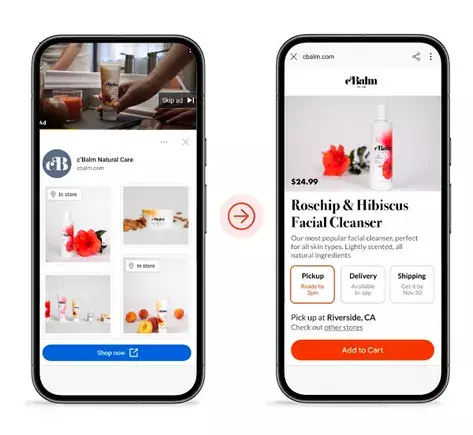Google’s latest development in ad technology reveals a significant shift in how brands will connect with consumers in the digital age. By integrating advertisements directly within AI-generated content, Google targets the growing trend of AI’s prominence in search experiences. This move isn’t merely about adding ads; it’s a strategic repositioning designed to capture attention in a landscape where traditional referral clicks are diminishing. Instead of expecting users to scroll for sponsored links, advertisers will now have the opportunity to embed their offerings seamlessly within the AI overview, ensuring that their brand remains visible during critical decision-making moments.
This evolution signifies a profound change in the consumer journey. As AI-generated responses become the default for many searches—especially on complex or problem-solving queries—the traditional click-through model faces obsolescence. Google’s approach to combat this involves placing sponsored content within these AI summaries, effectively placing the brand at the forefront of the ecosystem. While this innovation promises greater visibility, it also raises questions about the quality of user engagement. Will consumers scroll past these sponsored snippets in the AI response? Will they perceive this as intrusive or helpful? The answer likely lies in the quality of the ad content itself and its relevance to the user’s query, emphasizing the need for advertisers to craft hyper-targeted and contextually appropriate messaging.
Moreover, Google’s expansion of AI Max campaigns to include these features highlights a broader industry acknowledgment of AI’s central role in future advertising strategies. This move could significantly benefit brands that are willing to invest in more integrated, data-driven approaches, but it also requires a keen understanding of how to optimize ad placements within these AI interactions. The challenge for advertisers will be to balance funding these placements with ensuring the content remains compelling enough to garner user attention amidst an increasingly crowded digital space.
Creative Automation and Asset Generation: A New Frontier for Advertisers
Google’s enhancement of its Asset Studio with AI-powered content generation tools marks a pivotal moment for creative teams. Automating the production of visual and video assets—without sacrificing authenticity—will revolutionize how brands approach campaign development, especially during peak seasons like holidays. The ability to upload a simple product photo and generate realistic, scene-specific images is groundbreaking; it offers a streamlined path to creating rich media content that resonates with consumers and maintains visual consistency.
This innovation responds directly to the practical demands of modern marketing: scale, speed, and personalization. During holiday campaigns, where time is often limited and competition fierce, being able to quickly generate diverse and high-quality visuals gives brands a tangible advantage. Instead of outsourcing or spending countless hours in Photoshop, companies can leverage AI to produce compelling content that is both cost-effective and adaptable. Furthermore, the capacity for batch processing and text-to-video tools expands creative possibilities exponentially. Marketers can now craft multiple assets in minutes rather than days, allowing them to test, optimize, and iterate in near real-time.
However, critical reflection suggests that reliance on automation must be approached cautiously. While AI can generate visually compelling images, it might also risk diluting brand identity if not carefully monitored. Consistency in messaging, feel, and tone remains vital—especially during the high-stakes holiday period. As AI tools evolve, so too must marketers develop strict parameters and quality controls to ensure authenticity and brand alignment are maintained. The risks of generic or inauthentic content proliferating could undermine brand integrity if not managed properly.
Broadening Reach Through Enhanced Content and Platform Collaborations
Google’s expansion of shoppable YouTube masthead ads exemplifies a strategic effort to diversify advertising channels. Video content has established itself as an indispensable element of holiday campaigns, and integrating e-commerce directly into YouTube’s prime real estate effectively bridges the gap between inspiration and purchase. This feature transforms traditional video ads into mini storefronts, encouraging impulsive buying from a platform many consumers visit daily.
While the impact of immediate shopping capabilities within YouTube is promising, it also invites skepticism towards its long-term effectiveness. Will consumers respond positively to the seamless shopping experience, or will they perceive it as overly aggressive? The success of these shoppable ads will depend heavily on execution—whether they provide genuine value or simply disrupt the user experience. Nonetheless, the decision to embed e-commerce into popular content avenues demonstrates Google’s understanding of consumer behavior: that entertainment and shopping are increasingly intertwined.
Furthermore, the enhanced collaboration tools for ad creation—such as sharing in-development assets—address a common challenge faced by marketing teams: agility. During the holiday rush, being able to review, revise, and approve campaigns quickly is crucial. Google’s focus on improving these workflows indicates an understanding that speed and flexibility are just as important as creative brilliance. This capability could lead to more cohesive, iterative campaigns that adapt rapidly to trends, news, and consumer feedback, giving brands an edge over less nimble competitors.
Google’s new suite of advertising innovations is not just a series of upgrades—it’s a fundamental reimagining of digital marketing’s future. For those willing to embrace these changes, the potential for increased visibility, efficiency, and creative freedom is immense. Yet, it also demands a critical eye to navigate the risks of automation, ad saturation, and consumer skepticism. The holiday season could very well be the proving ground for these emerging tools, shaping a new era where AI and human ingenuity coalesce to craft more engaging, responsive, and effective advertising strategies.

